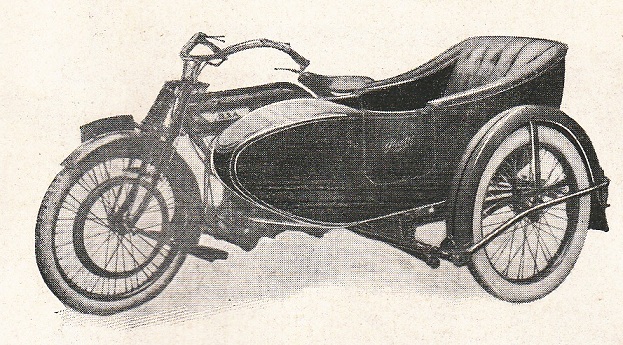 | |  |  | |  | | Finlay Brothers history site |
|
| | | | Preserving the bicycle and
motorcycle heritage of
Finlay Brothers, Elizabeth St
Melbourne, 1900-1961. |
| | |

An illustration of the Floater from an advertising brochure - private family collection. |
What drove the development of the Floater sidecar?
Was it simply a commercially motivated decision to capitalize on the flourishing motorcycle market of the era, or should it actually be seen as an early illustration of the firm's interest in designing, patenting and mass producing it's own inventions?
The Floater sidecar was a design patented by Finlay Brothers and marketed to the public on claims of superior characteristics, greater safety and improved suspension for rider comfort.
Robert Saward, in an article for Classic Motorcycling, suggested the Floater Sidecar appeared in late 1916, following Bob Finlay's use of one in a 24 hour trial.1 Saward also describes a visit by A.D. Finlay to the American Excelsior factory in 1919, and to the British B.S.A. factory in 1922, with the aim of securing overseas production of the design (under license).2 In Australia, production of the bodies was certainly outsourced to Proctor, Parker and Co.3
Proving the performance of their vehicles was an ongoing theme for sellers in the motorcycle trade, and the Floater seems to have been no exception, with an old Finlay Brothers' advertisement at the bottom of this webpage describing the Floater's involvement in a distance trial.
It appears that even the arena of sidecar racing was embarked upon. At a "V.M.C.C. Speed Contest" held on the Werribee Road on 21st December 1918, Finlay Brothers claimed that Excelsior motorcycles with Floater sidecars ran the first and second fastest times in the mile handicap for sidecar outfits (1st Bob Finlay, 2nd W.S. Clarke), with L.R. Buckridge (possibly a Finlay Brothers' showroom and sales department manager at the time), placing second also riding an Excelsior with Floater.4
Advertising by Finlay Brothers of this sidecar was prolific, and the following is a transcription of an article about the Floater which appeared in Adelaide's The Mail in 1918:
"FLOATER SIDECAR
An Australian Production
Messrs. Finlay Bros., of Elizabeth Street, Melbourne, have developed the Australian "Floater" sidecar chassis to such an extent that it has become popular among the more critical riders. The objective which originated the idea was to devise a sidecar chassis which would provide super comfort by eliminating the road shocks from sidecar chassis and the transmitted shock to the motor cycle. The illustration accompanying this article [above] shows how a great degree of flexibility is attained. The chassis is hinged through the main leaf spring at D. A is a sprial spring, which acts as a recoil to absorb the road shocks which would otherwise be passed through the sidecar wheel. It is clearly shown by the illustration how all road shock is absorbed - through the tyre, recoil spring, cross releef spring, and through the scroll body springs.
Messrs. Finlay Bros. claim, with apparent justification, that the secret of the "Floater" success lies in the unique design of the chassis. The triple system of insulation and flexible ball sockets absorb-all road shocks and abolish strains on chassis and motor cycle. The hinged wheel cradle permits of the knockout hub axle being securely bearinged at both ends, while the mudguard is securely attached. The liability of breakage encountered with overhanging axle is obviated. The full floating chassis and rear laminated spring, working in conjunction with the cushioned rigid bar connection, keep the motorcycle always at the right camber - eliminating "hanging in," which is such a detrimental and dangerous defeat in most sidecar outfits - relieve strain on connections, and guarantee cushion-like comfort. The scientific method of combining the actions of springs, hinges, and flexible ball sockets gives the necessary rigidity with the correct amount of flexibility to ensure freedom of steering, extreme durability, and the greatest efficiency. The main attachments are securely fitted below the level of the motor cycle wheel axles. The rigid bar is coupled to the saddle post. This method of attachment relieves the front forks of all side-drag, makes steering perfect, and naturally saves tyres from all excessive strains and wear. The car may be detached with the minimum of trouble in a few minutes.
We are indebted to Mr. L.R. Buckeridge, manager of the showroom and sales department of Messrs. Finlay Brothers, for the information and the illustration accompanying this article."5
References:
1. Robert Saward, "Some Victorian sidecars", Classic Motorcycling 8: 24.
2. Ibid.
3. Ibid.
4. The Argus (Melbourne, Vic:1848-1956), December 12, 1918, 2.
http://nla.gov.au/nla.news-article1409082
5. The Mail (Adelaide, S.A.: 1912-1954), December 7, 1918, 13.
http://nla.gov.au/nla.news-article63755521
|
| | | | | | |
|